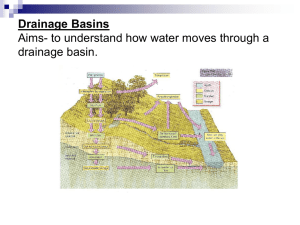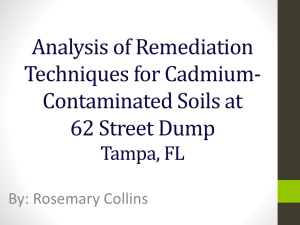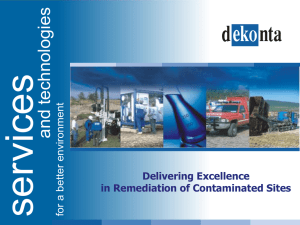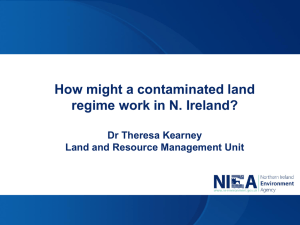Report with No Table of Contents Template
advertisement
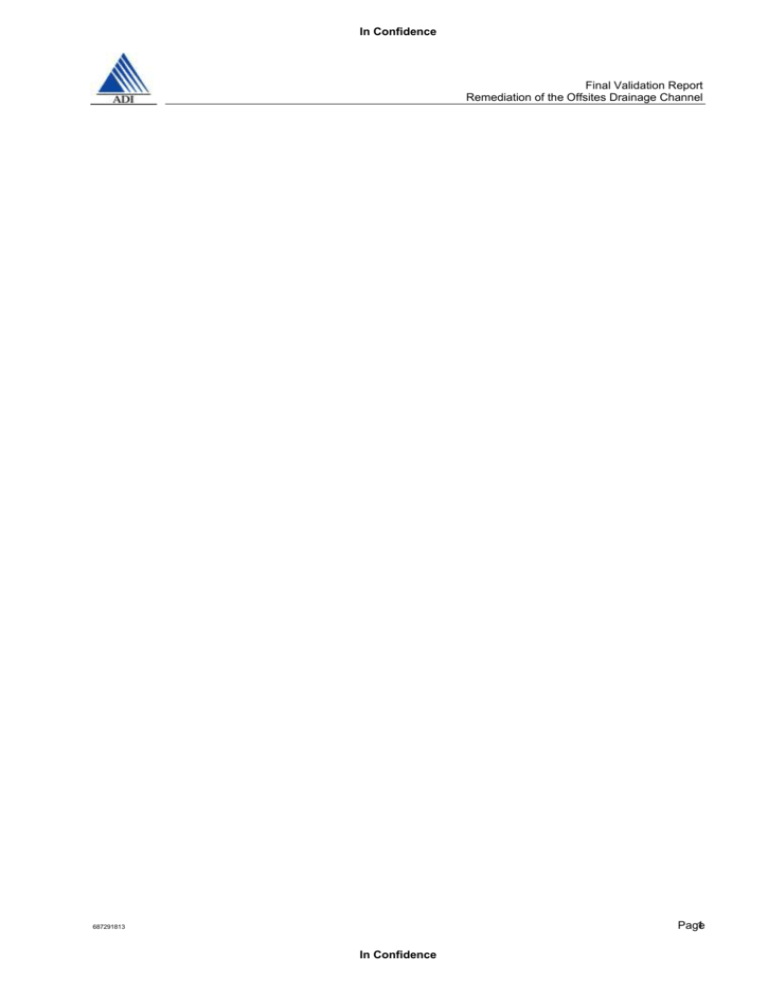
In Confidence Final Validation Report Remediation of the Offsites Drainage Channel 1 Page 687291813 In Confidence In Confidence Final Validation Report Remediation of the Offsites Drainage Channel REMEDIATION OF THE OFFSITES DRAINAGE CHANNEL FINAL VALIDATION REPORT Page 2 687291813 In Confidence In Confidence Final Validation Report Remediation of the Offsites Drainage Channel TABLE OF CONTENTS 1. INTRODUCTION ..................................................................................................................... 3 1.1 1.2 1.3 BACKGROUND .............................................................................................................. 3 OBJECTIVES ................................................................................................................. 4 SCOPE OF WORK .......................................................................................................... 4 2. SITE DETAILS ......................................................................................................................... 5 2.1 GENERAL ..................................................................................................................... 5 3. REMEDIATION AND VALIDATION ACTIVITIES .......................................................... 5 3.1 3.2 3.3 3.4 3.5 3.6 3.7 GENERAL ..................................................................................................................... 5 INVESTIGATION TRENCHES ............................................................................................ 5 EXCAVATION AND TRANSPORT TO THE HELIPAD .............................................................. 6 DISPOSAL OF CONTAMINATED SOIL ................................................................................ 7 VALIDATION PROGRAM .................................................................................................. 7 IMPORTATION OF BACKFILL ............................................................................................ 7 RESTORATION AND REVEGETATION ................................................................................ 7 4. ASSESSMENT GUIDELINES................................................................................................. 8 4.1 4.2 OFFSITE DISPOSAL CRITERIA ......................................................................................... 8 VALIDATION CRITERIA ................................................................................................... 9 5. ANALYTICAL RESULTS ....................................................................................................... 9 5.1 5.2 5.3 5.4 CONTAMINATED SOIL .................................................................................................... 9 VALIDATION SAMPLES ................................................................................................. 10 BACKFILL SAMPLES ..................................................................................................... 11 DATA QUALITY ............................................................................................................ 12 6. DISCUSSION........................................................................................................................... 14 7. CONCLUSION ........................................................................................................................ 14 8. REFERENCES ........................................................................................................................ 15 9. LIMITATIONS OF THIS REPORT ..................................................................................... 16 TABLES Table 1. Results of soil analyses from trench samples.................................................................................... 6 Table 2. Contaminant Thresholds based on total concentration analyses only ............................................... 8 Table 3. Contaminant Thresholds based on total concentration and TCLP results ........................................ 8 Table 4. Summary of Contaminated Soil Analyses – Total Heavy Metals..................................................... 9 Table 5. Summary of Contaminated Soil Analyses – TCLP for Mercury, Lead & Nickel .......................... 10 Table 6. Summary of Contaminated Soil Analyses – Total Petroleum Hydrocarbons ................................. 10 Table 7. Summary of Validation results ....................................................................................................... 11 Table 8. Summary of CleanfillSoil Analyses – Total Heavy Metals ............................................................ 12 Table 9. Summary of backfill analyses – Total Petroleum Hydrocarbons.................................................... 12 Table 10. Summary of Quality Assurance / Quality Control Criteria........................................................... 13 Page 1 687291813 In Confidence In Confidence Final Validation Report Remediation of the Offsites Drainage Channel ATTACHMENTS Attachment A Attachment B Attachment C Attachment D Attachment E Remedial Action Plan (RAP) Site photographs Waste classification report Calculation of the number of samples required from base of channel to validate the remediation Laboratory results, including QA / QC Page 2 687291813 In Confidence In Confidence Final Validation Report Remediation of the Offsites Drainage Channel 1. INTRODUCTION ADI Limited has commissioned several reports into the extent and degree of soil contamination at the Mulwala facility. The most recent and most comprehensive report, entitled “Environmental Site Assessment ADI Mulwala” URS 2001, summarised previous studies as well as reporting on a further comprehensive sampling program. A risk assessment was conducted on all the areas of contamination found. The Offsites Drainage Channel was identified as an area of high lead contamination with concentrations exceeding the ANZECC / NHMRC Environmental Investigation Levels (EIL) and the Health Investigation Levels (HIL), consequently another report was commissioned from URS, on the management options for the channel. This report found that the potential for the elevated concentrations of lead to represent an unacceptable risk to human health is low. The management options canvassed by the report were: To do nothing Leave the contamination in-situ and ensure that a good vegetation cover is maintained. Capping of the soil contamination to contain it and eliminate potential surface exposure and dust creation. Fencing of the area to exclude access. Excavate the contaminated soil and dispose off-site. ADI and Department of Defence decided after consulting with the EPA and local community, that the best long-term solution to the contamination in the Channel was to excavate the contaminated soil and dispose off-site. This report documents the work done to remove the contaminated soil and replace it with uncontaminated material and so leaving the site suitable for all uses. 1.1 Background The Drainage Channel is a open ditch approximately 2 metres wide and 1120 metres long that was used from when the ADI facility was constructed in the 1940s until 1989 to convey process effluent and stormwater from the Effluent Treatment Plant to the Murray River. After 1989, the flow was diverted to underground pipes. In the Effluent Treatment Plant (ETP), the waste nitric and sulphuric acids are neutralised with lime and the resultant saturated lime / calcium nitrate / calcium sulphate solution discharged to the river. The drainage channel was constructed with a clay bottom and sides. Over the years the calcium sulphate (gypsum) has changed the structure of the clay making it more porous and allowing a proportion of the effluent to soak into the ground rather than reaching the Murray River. The sediment on the bottom of the channel is reported as being up to 0.4 metres deep, with the depth decreasing with distance from the start of the channel at Bayly Street. Page 3 687291813 In Confidence In Confidence Final Validation Report Remediation of the Offsites Drainage Channel In the ADI facility, lead sheeting is used to protect parts of the plant from corrosion by medium strength sulphuric acid. A very small amount of lead is dissolved by the acid and also flows to the ETP with the waste acids. Approximately half of this dissolved lead is precipitated out of solution when the effluent is neutralised with lime and is incorporated in the gypsum sludge. The rest of the lead remains in solution in the effluent flowing to the River. Mercury was once used at the Mulwala Facility in various vacuum seals. Process upsets caused some of this mercury to be spilt into the plant sewer system. The mercury would slowly dissolve in the acidic plant effluent and be washed to the Effluent Treatment Plant where it would not be removed by the lime treatment and so it would pass through and enter the Drainage Channel. Mercury is not currently used on site. 1.2 Objectives This validation report has been prepared by ADI Mulwala Environment Section to document that the following objectives have been met: 1.3 Removal of soil / gypsum contaminated with lead and mercury in a safe and environmentally acceptable manner. Removal of a potential source of groundwater contamination in a safe and environmentally acceptable manner. Validation of residual soil and restoration of the area in accordance with NSW EPA, ANZECC and ADI requirements. Scope of work The remediation and validation works involved the following activities: Excavation of three trenches across the Channel and sampling from them, to determine the depth of the contamination. Preparation of a Remedial Action Plan (RAP) for the Drainage Channel. Presentation of the RAP to the EPA and Corowa Council for information and comment. Contractor supervision. Excavation of the contaminated soil. Transport of the contaminated soil to ADI and temporary storage on the Helipad. Classification of the contaminated soil according to NSW EPA regulations. Disposal of the contaminated soil. Validation of the in-situ soil to confirm compliance with NSW EPA regulations. Restoration of the Channel profile with clean backfill. Page 4 687291813 In Confidence In Confidence Final Validation Report Remediation of the Offsites Drainage Channel Revegetation of the Channel. A Remedial Action Plan (RAP) was prepared to document procedures for the remediation of the Channel and included site management procedures necessary to address environmental and safety issues. A copy of the RAP is in Attachment A. 2. SITE DETAILS 2.1 General The Offsites Drainage Channel is located to the south of Bayly Street the southern boundary of the Mulwala facility, providing a link between the facility and the Murray River. A site plan is included as Figure 1. The length of the channel is about 1100 metres, with a base width of about 2 metres. The channel is tree lined for parts of its length, and had prior to the remedial works, a continuous grass cover over the whole of the invert. A series of photographs of the channel before and after the remedial works were undertaken, are included in Appendix B. 3. REMEDIATION AND VALIDATION ACTIVITIES 3.1 General Based on the Mulwala Site Environmental Assessment conducted by URS, the lead concentration in the surface of the base of the channel was about 300 to 600 mg/kg, which exceeded the “Solid waste” category of the NSW EPA, unless leachate tests were done. However, because excavation was to occur to a depth of about 0.5 metres, full sampling and analysis to determine the disposal of the contaminated soil was left until the material was stockpiled on the concrete Helipad. 3.2 Investigation trenches Three trenches were dug by a backhoe on 8 August 2001 across the channel at different locations, down to a depth at which hard clay was found. The location of these trenches is also shown in Figure 1. Samples were taken from the sides of these trenches and analysed for calcium, nitrates, sulphates, lead and mercury. These analytical results are shown below in Table 1, and confirmed that the lead and mercury contamination was confined to the top layer ( < 0.3 m) and that excavation down to the heavy clay would be adequate to ensure that the remaining soil concentrions were under the EIL levels. Page 5 687291813 In Confidence In Confidence Final Validation Report Remediation of the Offsites Drainage Channel The results also indicated that it would be impractical to try and remove the nitrate contamination because it has been washed much further into the soil, and possible into the groundwater metres below. This meant that it would only be possible to achieve the second objective of the plan, removal of a potential source of groundwater contamination, with respect to lead and mercury. The soil below the drain would continue to act as a source of contamination of nitrates and sulphates into the groundwater. Table 1. Results of soil analyses from trench samples Location Depth cm PH Nitrate mg/kg Sulphate mg/kg Calcium mg/kg Lead mg/kg Mercury mg/kg Trench 1, 30 6.7 18 2000 1400 750 1.4 80 6.2 60 1900 1600 240 3 120 4.2 60 530 610 360 0.08 30 3.8 380 3400 3000 230 0.28 60 4.2 240 450 1500 52 0.13 60 4.2 210 280 1300 47 0.13 120 4.1 180 330 850 21 0.05 40 6.7 14 5100 5900 340 0.44 60 5.6 80 3800 2100 140 0.2 100 5 160 1800 1100 130 0.05 Trench 2 Trench 3 3.3 Excavation and transport to the Helipad Excavation and transport of the contaminated soil from the base of the channel was done by Judd Contracting of Yarrawonga, under supervision of the Environmental Section of ADI Limited. The material was removed from the channel using a traxcavator which was able to reach right across the channel to scrape material from the opposite side. The highly manoeuvrable traxcavator was able to work between most of the trees lining the banks of the channel. Only one tree had to be removed to allow access to the sides of the channel, although some small branches were lopped. Trucks were usually able to park along side the traxcavator and be loaded directly without double handling of the soil being required. The loads were tamped down by the back of the traxcavator’s bucket to minimise any loss on the trip into ADI. No spillages occurred during the transport to the Helipad. Access into ADI was via the REFA gate in Bayly Street to minimise the distance to be traveled. A security guard was stationed at this entrance during the excavation period to maintain site security. Approximately 2400 tonne of soil were removed from the Channel and stockpiled on the Helipad. Page 6 687291813 In Confidence In Confidence Final Validation Report Remediation of the Offsites Drainage Channel 3.4 Disposal of contaminated soil The contaminated soil on the helipad was sampled by WSL Consulting, to enable classification according to the EPA Waste criteria. Four soil samples were compiled representing the four quadrants (North, South, East & West) of the stockpile. The results of the analyses are set out in Section 5.1 and the classification report from WSL is in Attachment C. The WSL classification report was sent to Corowa Shire Environment & Planning Engineer who, on the advice of the EPA, accepted the material for disposal at the Corowa Shire Landfill. The stockpile of contaminated soil was transported to the Corowa Landfill facility during the period 5/11/01 – 12/11/01. 3.5 Validation program Samples were taken from the undisturbed soil along the base of the channel after the contaminated soil had been removed according to the NSW EPA brochure, “Contaminated Sites: Sampling Design Guidelines” with the minimum size hot spot to be located with 95% confidence being 30 metres diameter. This meant that 22 samples were taken along the base of the channel at 25 metre intervals. Computation details are included in Attachment D. As a check, using Table A in the brochure, for the area of the channel, the minimum number of samples required is 8. Analytical consultants, WSL, selected the exact sampling locations, took the samples, transported them back to the laboratory in Melbourne and conducted the analyses. All samples were analysed for calcium, sulphate, nitrates, mercury and lead using NATA approved methodology. During the same visit, the WSL consultant, took four samples from the stockpile of material stored on the Helipad, and four samples of the backfill material. 3.6 Importation of backfill Backfill material was sourced from an area at ADI Mulwala that had no history of association with the processing plant. Prior to being placed into the channel, WSL Consulting compiled four composite samples from the stockpile adjacent to the channel. These samples were analysed for heavy metals, petroleum compounds and pesticides. The results of these analyses are set out in Section 5.3. 3.7 Restoration and revegetation The sandy soil was spread over the channel to approximately the original profile of before the start of the remediation work. A selection of indigenous trees and grasses were planted in and along the banks of the channel. Page 7 687291813 In Confidence In Confidence Final Validation Report Remediation of the Offsites Drainage Channel 4. ASSESSMENT GUIDELINES 4.1 Offsite disposal criteria The NSW EPA guidelines, Environmental Guidelines : Assessment, Classification, and Management of Non-liquid Wases, July 1997, set out contaminant threshold values for a number of waste classifications. These classifications are for “inert”, “solid” and “industrial” waste. The guidelines also give values for leachable concentrations (TCLP) for the three classifications. Tables 2 and 3 summarise values for each waste classification, with regard to total contaminant thresholds and TCLP values. Table 2. Contaminant Thresholds based on total concentration analyses only Mg/kg Inert Waste Solid Waste Industrial Waste Arsenic 10 100 400 Cadium 2 20 80 Chromium (VI) 10 100 400 Lead 10 100 400 Mercury 0.4 4 16 4 40 160 Nickel Table 3. Contaminant Thresholds based on total concentration and TCLP results Mg/kg Inert Waste Solid Waste Industrial Waste TCLP conc. Total conc. TCLP conc. Total conc. TCLP conc. Total conc. Arsenic 0.5 500 5.0 500 20 2000 Cadium 0.1 100 1.0 100 4 400 Chromium (VI) 0.5 1900 5 1900 20 7600 Lead 0.5 1500 5 1500 20 6000 Mercury 0.02 50 0.2 50 0.8 200 Nickel 0.2 1050 2 72 8 288 Page 8 687291813 In Confidence In Confidence Final Validation Report Remediation of the Offsites Drainage Channel 4.2 Validation criteria The Australian and New Zealand Environment & Conservation Council and the National Health and Medical Research Council (ANZECC / NHMRC) Guidelines for the Assessment and Management of Contaminated Sites, Jan. 1002, was used as the basis for assessment. These guidelines have been set on the basis of current toxicological data and are considered to be conservative. In general the investigation levels are considered adequate to protect the most sensitive receptors. Where the levels of chemcals in soils are below the ANZECC / NHMRC guidelines, the condition of the land is considered to satisfy the requirements for protection of all beneficial uses (except groundwater quality). 5. ANALYTICAL RESULTS Results of all samples were compared against the above assessment guidelines. Certificates of laboratory results are presented in Attachment E. 5.1 Contaminated soil Four composite samples were prepared from the stockpile of contaminated soil. The analytical results reported elevated concentrations of lead in all four samples as detail below in Table 4. Table 4. Summary of Contaminated Soil Analyses – Total Heavy Metals Mg/kg As Cd Cr total Cr(VI) Cu Pb Hg Ni Zn North 8 <0.2 64 <1 20 310 2.3 40 56 South 10 <0.2 76 <1 23 290 1.4 36 50 East 7 <0.2 52 <1 19 180 1.5 30 61 West <5 0.3 110 <1 18 610 4 72 80 348 2.3 Average Criteria * Inert waste 10 2 10 10 0.4 4 Solid waste 100 20 100 100 4 40 Industrial waste 400 80 400 400 16 160 Contaminant Threshold Values for Waste Classification without TCLP Subsequent to the receipt of the above results, TCLP analysis for mercury, lead and nickel were performed on two composite samples. The results of the leachable concentration analyses for heavy metals indicated that all samples were below the NSW “Inert Waste” category. The report from WSL Consulting certifying this classification is in Attachment C. Page 9 687291813 In Confidence In Confidence Final Validation Report Remediation of the Offsites Drainage Channel Table 5. Summary of Contaminated Soil Analyses – TCLP for Mercury, Lead & Nickel Mg/kg Pb Hg Ni Composite A 0.23 <0.001 40 Composite B 0.45 <0.001 36 Inert waste 0.5 0.02 0.2 Solid waste 5 0.2 2 Industrial waste 20 0.8 8 Criteria * Contaminant Threshold Values for Waste Classification with TCLP Table 6. Summary of Contaminated Soil Analyses – Total Petroleum Hydrocarbons Mg/kg TPH C6-C9 TPH C10-C14 TPH C15-C28 <TPH C29-C36 North <20 34 62 78 South <20 33 70 63 East <20 <20 <50 53 West <20 24 140 200 Inert waste 650 5000 * Solid waste 650 10000 * Industrial waste 2600 40000 * Criteria * 5.2 Criteria is for total C10 – C36 Validation samples Twenty two samples were taken from the base of the channel and analysed for calcium, sulphates, nitrate, mercury and lead. All analysis results were below the ANZECC/ NHMRC Investigation guidelines. Page 10 687291813 In Confidence In Confidence Final Validation Report Remediation of the Offsites Drainage Channel A summary of the laboratory results of the validation samples is presented in Table 7. Table 7. Summary of Validation results Mg/kg Calcium Sulphate Nitrate (N) Mercury Lead Sample 1 1400 1000 28 0.05 50 Sample 2 740 160 260 0.15 61 Sample 3 1100 920 610 0.43 100 Sample 4 710 800 330 0.43 93 Sample 5 2200 3100 710 0.07 37 Sample 6 5300 4200 410 0.1 35 Sample 7 1000 420 120 0.17 43 Sample 8 2000 1600 140 0.12 27 Sample 9 2700 1600 360 0.22 27 Sample 10 1100 440 480 0.21 79 Sample 11 1200 560 420 0.35 81 Sample 12 4500 2100 400 0.14 79 Sample 13 3000 3600 79 0.15 72 Sample 14 1100 46 270 0.05 74 Sample 15 1800 290 410 0.05 21 Sample 16 1300 110 52 0.12 150 Sample 17 1300 93 100 0.08 96 Sample 18 1600 240 170 0.17 38 Sample 19 1300 810 56 0.05 39 Sample 20 1500 630 300 0.07 23 Sample 21 3400 1600 45 0.16 34 Sample 22 2300 580 130 0.05 67 30 600 1 600 Criteria NEPM HIL 5.3 NEPM EIL 2000 Background 150 10 Backfill samples Composite samples were taken of the four piles of soil proposed to be used as backfill. The results of the analyses are summarised in Tables 8 & 9. The laboratory analysis for chromium was for both total chromium, which includes the normally common Cr (III) as well as the rarer, toxic for Cr (VI). Page 11 687291813 In Confidence In Confidence Final Validation Report Remediation of the Offsites Drainage Channel Table 8. Summary of Back fillSoil Analyses – Total Heavy Metals Mg/kg As Cd Cr (total) Cr (VI) Cu Pb Hg Ni Zn Pile A1 <5 <0.2 12 <1 6 7 0.09 9 22 Pile B2 <5 <0.2 11 <1 5 7 0.09 8 18 Pile B3 <5 <0.2 13 <1 6 6 0.07 9 18 Pile B4 <5 <0.2 12 <1 5 5 0.08 9 17 Environmental Investigation Level (NEPC 1999) 20 3 400 100 600 1 60 200 Health Investigation Level 200 40 24% 2000 600 30 600 14000 Criteria * NEPC (HIL) Table 9. Summary of backfill analyses – Total Petroleum Hydrocarbons Mg/kg TPH C6-C9 TPH C10-C14 TPH C15-C28 <TPH C29-C36 Pile A1 <20 <20 <50 <50 Pile B2 <20 <20 <50 <50 Pile B3 <20 <20 <50 <50 Pile B4 <20 <20 <50 <50 65 1000* Criteria * Environmental Investigation Level NEPC Health Investigation Level NEPC 5.4 Data quality Verification of the removal of the contaminated soil was verified by visual inspection by members of the Environmental Section of ADI Limited. Quality assurance checks were conducted by the analystes, WSL Consultants. These involved blank samples, spiked and duplicate samples. A summary of the results of these analytical checks is set out in Table 10, and the full reports are in Attachment E. Page 12 687291813 In Confidence In Confidence Final Validation Report Remediation of the Offsites Drainage Channel Table 10. Summary of Quality Assurance / Quality Control Criteria Objective Summary of results Compliance Agreement between visual inspection and laboratory results All samples Yes Chain of Custody documentation Completed Completed in full Yes Sample analysis and extraction holding times Comply with reference AS4482.1 All within guidelines Yes Analysis of 5% field split duplicate samples RPDs within 30-50% AS4482.1 All RPDs were <20% Yes Analysis of 5% field blind replicated samples RPDs within 30-50% AS4482.1 All RPDs were <20% Yes Analysis of laboratory method blanks No contamination of blanks All non-detects Yes Recoveries of 70-130% All recoveries in range of 77% 127% Yes RPDs within 20-35% All RPD’s were <20% Yes Comparison of field and analytical data Analysis of spike recoveries Analysis of laboratory duplicates Reference Page 13 687291813 In Confidence In Confidence Final Validation Report Remediation of the Offsites Drainage Channel 6. DISCUSSION The results of the heavy metal analyses of the soil removed from the channel were reported below the NSW “Inert Waste” category and so disposal to the Corowa Shire Landfill is appropriate. The results of the validation samples collected from the base of the channel all reported heavy metals below the ANZECC/NHMRC Environmental Investigation Guidelines. It is therefore reasonable to conclude that all of the soil contaminated with heavy metals has been removed. The results of the backfill soil sample analyses found all heavy metal and TPH analyses below the ANZECC/NHMRC Environmental Investigation Guidelines, and so use of this material as backfill is justified. 7. CONCLUSION The process effluent from the ADI Mulwala, containing a suspension of gypsum and some lead and mercury was drained to the Murray River via an open unlined channel for many years. This practice has now stopped. While the drain was in use, much of the gypsum and heavy metals in the effluent, precipitated along the base of the channel. A report by URS consulting (Site Assessment Report 2001) found that concentrations of lead exceeded the EIL and HIL in some samples. ADI in consultation with Defence and the local community decided that remediation of the site by removing the contaminated material and disposing of it offsite was the best long term solution to the situation to allow full beneficial use of the site. The results of the remediation and validation program indicate that the project objectives have been achieved and the areas of contaminated soil have been removed and replaced with uncontaminated material. The project objective of eliminating a potential source of groundwater contamination has only been achieved with respect to lead and mercury. The soluable nitrates and sulphates from the original effluent, have been washed down much deeper into the soil and possible into the groundwater, over 10 meters deep. Remediation of this contamination is not possible by the simple excavation technology used in this project. Page 14 687291813 In Confidence In Confidence Final Validation Report Remediation of the Offsites Drainage Channel 8. REFERENCES ANZECC & NHMRC Guidelines for the Assessment and Management of Contaminated Sites, Australian and New Zealand Environment and Conservation Council, and National Health and Medical Research Council, January 1992. Australian Standard Guide to the Sampling and Investigation of Potentially contaminated Soil. Part 1: Non-Volatile compounds, AS 4482.1, 1997. NSW EPA Environmental Guidelines: Assessment, Classification, and Management of Non-liquid Wastes, NSW Environment Protection Authority, July 1997. NSW EPA Guidelines for Consultants Reporting on Contaminated Sites, NSW Environment Protection Authority, November 1997. Page 15 687291813 In Confidence In Confidence Final Validation Report Remediation of the Offsites Drainage Channel 9. LIMITATIONS OF THIS REPORT The advice provided in this report only relates to the project described herein and ADI – Limited accepts no responsibility for other use of the data. Where laboratory tests, geophysical tests and similar work have been performed and recorded by others the data is included and used in the form provided by others. The responsibility for the accuracy of such data remains with the issuing authority, not with ADI-Limited. This report is based on information obtained from the investigation locations, test points and sample points and is not warranted in respect to the conditions that may be encountered across the site at other locations. The actual subsurface conditions between sample points may differ substantially from those reported at the sample points. However, the sample point locations were chosen to be representative of the general area. Page 16 687291813 In Confidence In Confidence Final Validation Report Remediation of the Offsites Drainage Channel Page 17 687291813 In Confidence In Confidence Final Validation Report Remediation of the Offsites Drainage Channel Page 18 687291813 In Confidence In Confidence Final Validation Report Remediation of the Offsites Drainage Channel Page 19 687291813 In Confidence In Confidence Final Validation Report Remediation of the Offsites Drainage Channel Page 20 687291813 In Confidence In Confidence Attachment D Final Validation Report Remediation of the Offsites Drainage Channel CALCULATION OF THE NUMBER OF SAMPLES REQUIRED FROM BASE OF CHANNEL TO VALIDATE THE REMEDIATION Basis: NSW EPA, Contaminated Sites: Sampling Design Guidelines, 1995, Procedure A, page 16. This method is based on detecting circular hot spots with 95% confidence using a square grid sampling pattern. Equations used: G = R/ 0.59b N = A/ G2 Where n = number of sampling points required. A = size of the sampling area, m2 G = distance between two sampling points, ie, the grid size. R = radius of the smallest hot spot that the sampling intends to detect. For this area, let R = 15 metres. And the sampling area A = = Hence, G And, n = 15/ 0.29 = 25 m. = A / G2 150 m @ 3 m wide + 250 m @ 2 m wide +400 m @ 1.5 m 1550 m2 = 1550 / ( 25 * 3 ) where the area of a grid “square” is taken as 25 m *3 m as the sampling area is a long narrow area rather than a wide “square“ area. = 22 So, the number of samples to be taken is 22 at a spacing of 25 metres. Page 1 687291813 In Confidence




